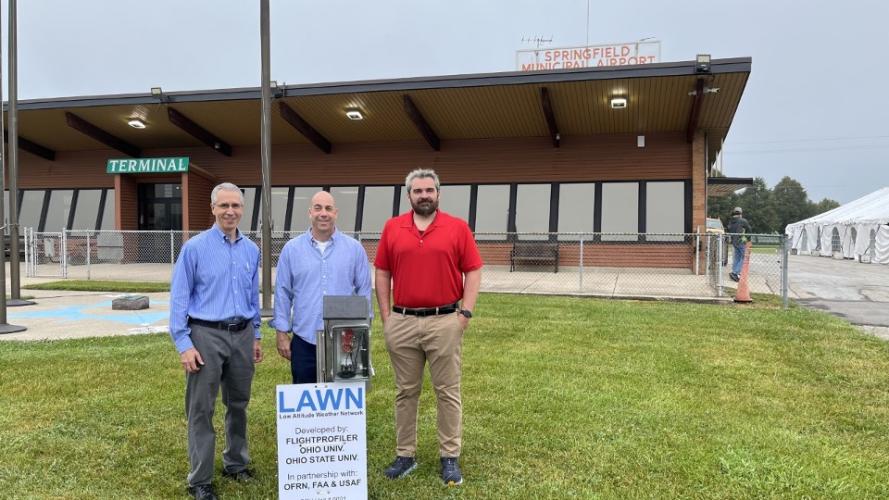
OHIO team soft launches first sensor in low altitude weather network

For the state of Ohio, supporting research in advanced air mobility has been a top priority — a priority shared by Chad Mourning, assistant professor in the School of Electrical Engineering and Computer Science, and his collaborators.
In 2021, Mourning was awarded one of Ohio Federal Research Network’s awards for a low altitude weather network (LAWN). His team completed the soft launch of their first unit at the National Advanced Air Mobility Industry Forum on August 22, 2022.
“We have an issue where we go to the Weather Channel and the satellite is telling you about the weather at 10,000 feet. There can be a big difference in the weather as we experience it on the ground and the weather at 10,000 feet,” Mourning said.
To alleviate this problem and improve accuracy in weather forecasting, Mourning’s team, in collaboration with researchers at Ohio State University and FlightProfilier, was tasked with designing a network of ground-based sensors to gather data measuring visibility around Ohio’s Springfield-Beckley Airport. This network will support drones with their gathered data.
Using techniques in machine learning, the team plans to develop a low-cost distributed automated weather observing system (AWOS). While this project was initiated by the state of Ohio, any advancement in developing a cost efficient AWOS would assist both public and private sector partners in improving weather measurement strategies.
“The goal is to get 25 of these units deployed at the Springfield-Beckley Airport. After launching the first unit, we still need to improve the machine learning model, so we can tag real data with our expected value to train our model,” Mourning said.
The project has been and continues to be a collaborative effort with both external and internal partners. Ohio State University is developing the enclosure for the device, FlightProfiler is receiving and visualizing the data and OHIO is working on the middleware, including the networking, machine learning sensor and cloud computing.
Within the OHIO team, students Justin Murray, Dylan Wright, Treyce Albin, Hirehalli Ramachandrarajeurs, Sambrama Sathyashreeurs, Lakshmi Kadaru and Ganesh Sarakadam have been collectively building pieces of prototype. Utilizing their own skillsets, the students have independently worked on the sensor’s camera, machine learning program, data visualization and the API.
“These sensors will work autonomously since they are off grid and solar powered. If one goes down, it’s okay because they are independent,” Mourning said.
Mourning describes how LAWN will be tapped into the Internet of Things, a system of objects with the processing ability to connect and communicate with other devices in a network. These devices are synonymous with light switches, appliances and thermostats commonly associated with “smart homes.” In this application, however, the network of devices are the weather monitoring sensors in LAWN.
Ultimately, this project has highlighted the power of collaboration as partners work together to advance research in advanced air mobility.
“Once we complete this project, our hope is to pitch its utility to the Federal Aviation Administration, the National Oceanic and Atmospheric Administration and the state of Ohio,” Mourning said.
